Izayoi (Los Angeles, CA)
Izayoi
132 S Central Ave, Los Angeles, CA 90012
213.613.9554
www.fooddigger.com/RestaurantDetail.aspx?id=20900 (FoodDigger, restaurant has no web site)
Wed 08/26/2009, 07:50p-10:50p
Izayoi's story begins with its owner and head chef, Junichi Shiode, who previously helmed Sushi Ryo, a well-regarded, but not particularly bustling place in Hollywood. Though a favorite of those in-the-know, Shiode-san shuttered Sushi Ryo and reincarnated the place as Izayoi in June of 2005. Izayoi is considered an izakaya, basically a Japanese restaurant primarily focusing on small plates, or "tapas"-style food meant to be eaten while drinking (alcohol). It's a relatively uncommon concept here in the States, but has been catching on in recent years.

Located in the heart of Little Tokyo, Izayoi is situated along a row of modern-looking storefronts, right next to a Quizno's. Catty-corner is infamous yakitori-ya Kokekokko, which just happens to be one of Shiode-san's favorite restaurants. Parking is free in the nearby Office Depot lot. Note the "B" rating, par for the course for Chinese joints, but rare among Japanese eateries.

Inside, the room is split between a large, open kitchen-cum-sushi bar and table seating. It's a fairly austere, but comfortable, environment.
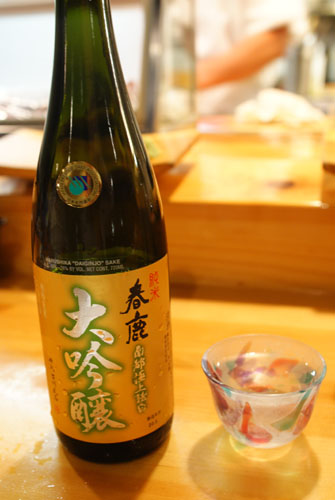
To drink, we started with the Harushika Junmai Daiginjo sake, which was brought by Dason, a reader of mine whom I'd met the previous night at Providence. Harushika means "spring deer," and is a 50% seimaibuai sake from Nara Prefecture. It was soft, smooth, and easy-drinking, with a light fruitiness over a backbone of sweet rice--quite delicious. I'd had Harushika's namazake previously at Urasawa, and their junmai at R23; both were positive experiences.
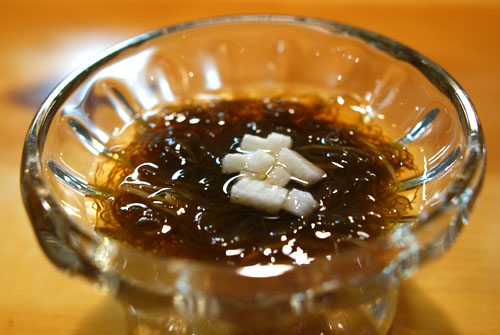
1: Mozuku
This was my first experience with mozuku, a type of seaweed primarily from Okinawa. It had a very fine, very stringy consistency with a bit of crispness to boot, and was served here in a transparent, slimy, gelatinous mass. Flavor-wise, the mozuku was sweet and briny, with a delightful finish of ginger. A nice start to the meal.
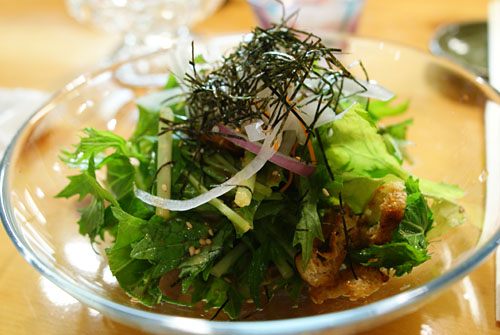
2: Mixed Green Salad
We moved on to a light, refreshing salad. I appreciated its slightly bracing tang and crunchy texture, along with its simultaneously sweet and savory flavor. The most interesting part of the dish, though, was the use of slivers of you tiao, or Chinese-style fried breakfast doughnuts, which added a palpable weight to the salad.
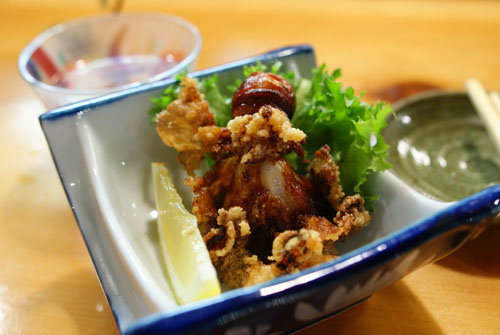
3: Idako
This was fried baby octopus from Japan. Initially, I tasted the crisp, rich, savory, oily crust, but this then gave way to the chewy, subtly sweet flesh of the octopus, which was immensely satisfying. Superb.
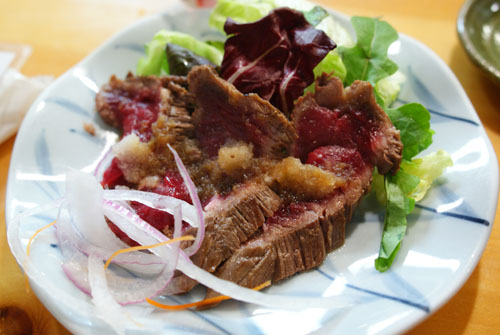
4: Beef Tataki
A presentation of seared beef filet sashimi, accompanied by onion and daikon oroshi. The meat itself was actually quite mild, so the key was to experience the contrast between the tangy onion and sweet daikon over the canvas of beef.
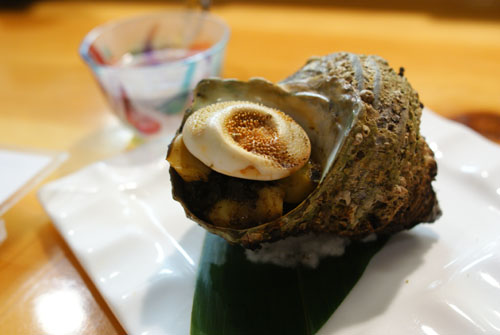
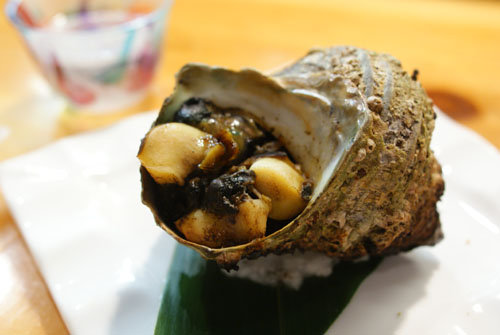
5: Sazae Tsuboyaki
This was a first for me: sazae, or turban shell, a type of sea snail. Here, it was done tsuboyaki-style, grilled in its own shell with kombu. I'll admit that it was a rather intimidating-looking dish when it was brought out, and note the large calcareous operculum "door" to the shell, removed in the second photo. The sazae's flesh was snappy, sweet, and slightly briny, with a bit of savory char flavor as well. I also had the snail's innards, which were mildly bitter; the entrails' strong taste was tempered by the use of kombu, which lent a great, vegetal tang to the entire dish.
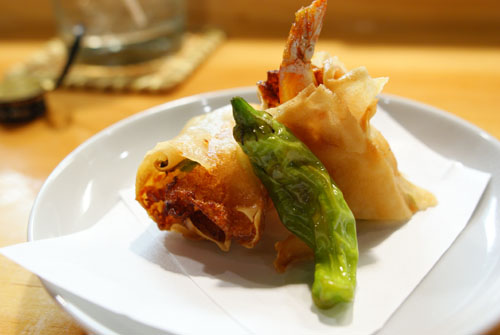
6: Ebi-Jalapeno Spring Roll
Taken by itself, the shrimp was sweet, soft, and nicely contrasted by the roll's crunchy wrapper. However, the key here was the jalapeno and the hot dipping sauce, both of which accented the shrimp's sweetness beautifully with a distinct spiciness. One of the best egg rolls I've had.
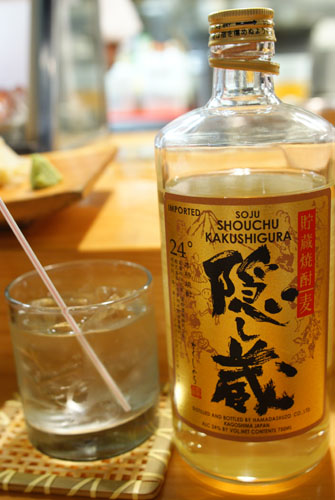
With our sake dispensed with, it was time to move on to the harder stuff: shochu, specifically the Kakushigura Mugi barley shochu from Hamada Shuzo brewery in Kagoshima [$42]. Aged in oak, which explains the drink's golden tinge, it had a woody, smoky, earthy aroma that was distinctive yet smooth, almost reminiscent of whiskey in fact. Here, we had it on the rocks, as well as mixed with oolong tea.
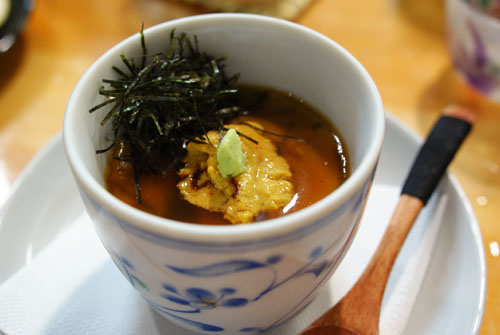
7: Cold Chawanmushi
Just in time for summer was this refreshing chawanmushi, served cool, containing egg, chicken, shiitake, uni, kamaboko (fish cake), fresh wasabi, and nori. It was definitely one of the better chawanmushis I've had, with the chicken adding a superb textural play and gravity to the dish, while the wasabi provided an excellent counter to the creaminess and weight of the egg.
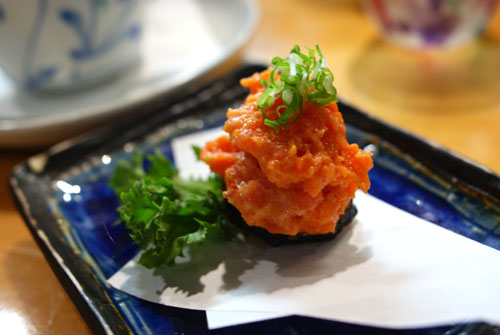
8: Spicy Tuna
The following bite was spicy tuna tartare, topped with scallion, atop a crispy rice cracker. A seemingly pedestrian dish, it was nonetheless delicious. I first was able to experience and enjoy the mild creaminess of the tuna, with the heat coming in only later on the lingering finish. The rice cracker, meanwhile, proved a superb textural contrast.
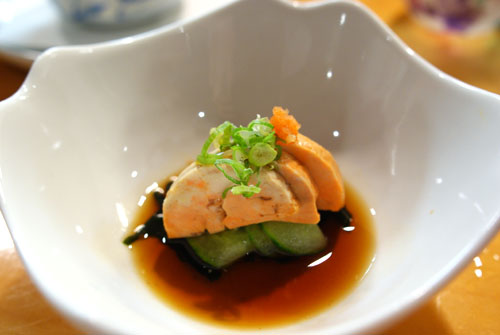
9: Ankimo
Ankimo, or monkfish liver, accompanied by scallion, momiji oroshi, kombu, and cucumber. This "foie gras of the sea" was noticeably milder than most, with a slight brine that was countered by the cool, crisp cucumber.
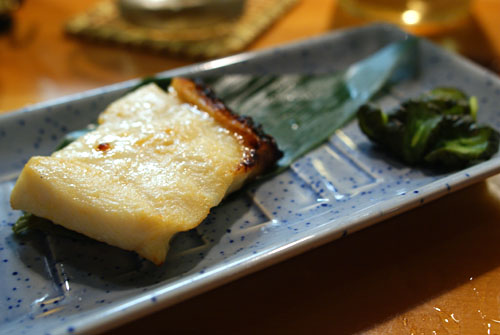
10: Chilean Sea Bass
Though I'm not a huge fan of Chilean sea bass, I did enjoy this preparation, marinated in miso. This gave the fish a slightly sweet flavor to go along with its unctuous, oily savoriness and supremely flavorful skin. At the same time, the tart pickles were key in balancing the weight of the soft, tender flesh. It actually reminded me a lot of Nobu's world-famous miso-marinated black cod.
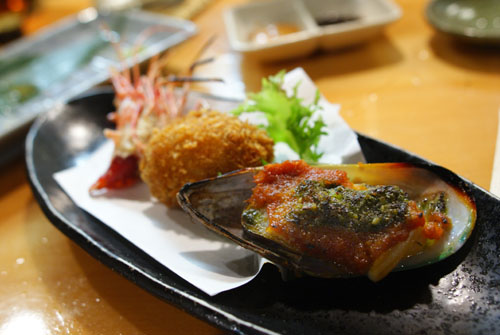
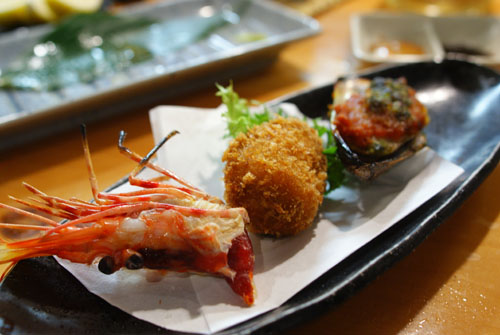
11: Mussel, Croquette, Shrimp Head
Our last course before the sushi gauntlet was this troika, served with two condiments: a tonkatsu sauce and a ketchup/mayo/honey sauce. I started with the mussel, baked in tomato sauce. The sauce added a significant gravity to the mollusc, tempering its brine with a marked sweetness. Next up was the shrimp croquette, my favorite of the trio: creamy, sweet, soft, with lovely chunks of shrimp interspersed within. Finally, we had shrimp heads, briny and sweet, with the body to be served next.
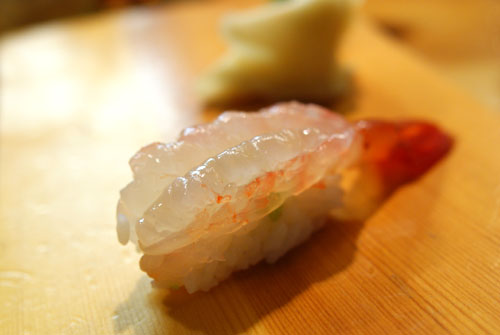
12: Amaebi
We had the head, now we have the body. This was basically your archetypical amaebi--snappy translucent flesh, lightly salty, subtly sweet, heightened by a finish of wasabi. Quite good.
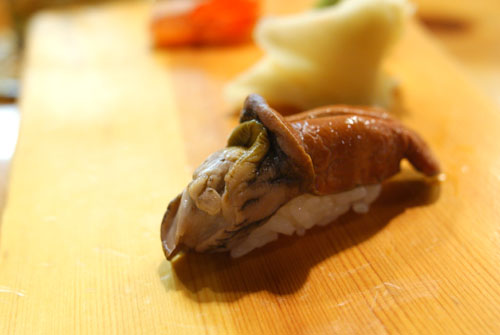
13: Sazae
Remember the sazae above? Before, we ate the body of the snail, now we'll consume the rather funky-looking foot. It was exceedingly crunchy, almost rubbery in fact, and had a very briny, ocean-y flavor that was fortunately countered by wasabi.
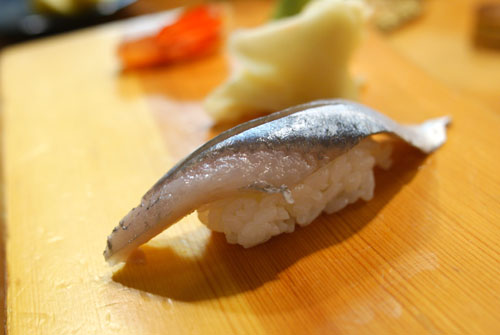
14: Sanma
A.k.a. pike mackerel, this is something I'd only had before at Urasawa. However, while Hiro-san "grills" the fish with a hot, long rod, the sanma here was served completely raw. It was delicious, with a prominent, yet delicate fishiness.

15: Toro
This looked quite dark for toro, so I was pleasantly surprised when I found that it was super soft, melt-in-my-mouth almost, and quite unctuous, though it wasn't as rich or as oily as the best toros I've had. Still, it was rather tasty.
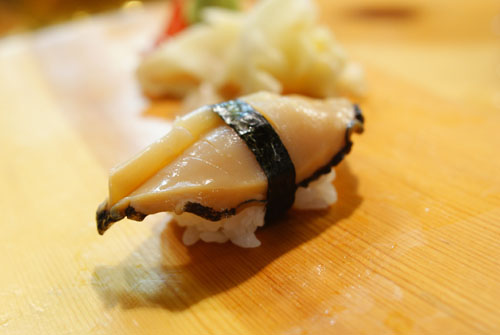
16: Awabi
Though the awabi here looked like that from Go's Mart, it didn't have Go's divine texture, being quite a bit crunchier. Nevertheless, it did have a brackishly sweet flavor to it, and went superbly with the rice.
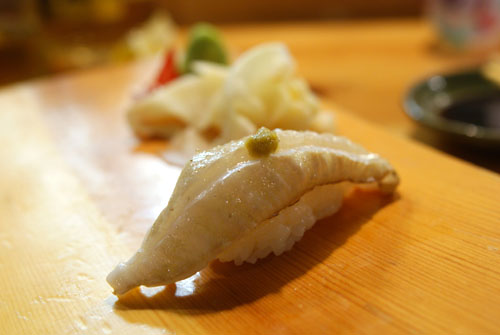
17: Engawa
Engawa is a relatively rare item, one that I've only had before at Sasabune and Sushi Zo. It's basically halibut fin muscle, normally a tougher cut of the fish. This preparation, however, was surprisingly tender, with a great sour/salty tang thanks to the yuzu kosho. Impressive.
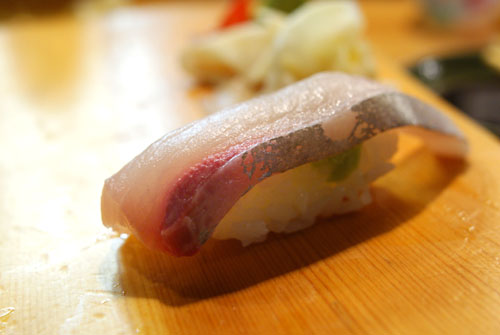
18: Kanpachi
Up next: kanpachi, or amberjack. In terms of taste, it was fairly typical, with a clean, mild flavor accented by the fire of wasabi. It was more impressive texturally, with a creamy, yet subtly snappy body.
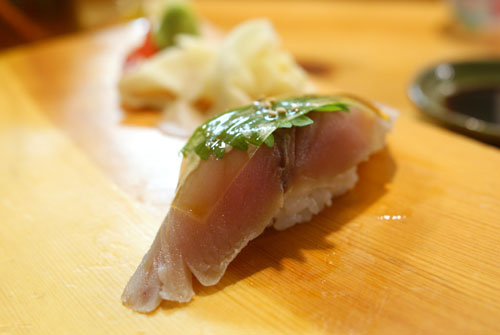
19: Saba
This was mackerel from Japan, topped with kombu. Though saba can often times be an assertive-tasting fish, it was tempered significantly here by the seaweed, which resulted in an almost sweet flavor to the sushi.
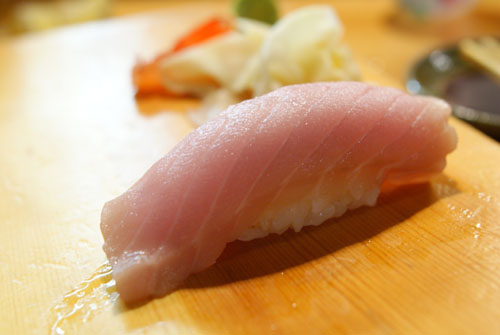
20: Shiro Sake
Now here was a first for me: "white salmon" from Alaska. Also known as "ivory salmon," it's a type of King salmon with an extra enzyme that can process the carotene that normally collects in and colors a salmon's flesh. It was quite a different beast indeed, with a much heavier, heartier complexion, but blunter, milder taste.
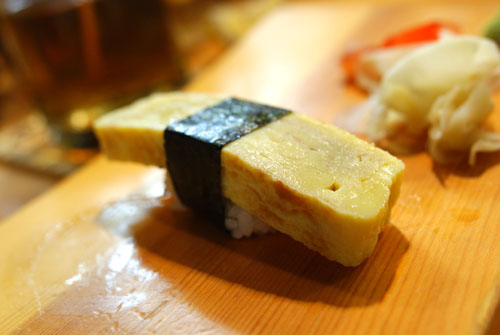
21: Tamago
Tamago in the middle of the meal seemed a bit strange, but we went with the flow. It was a cold, dense version, with your prototypical sweetness, but also possessing a great seaweed tang.
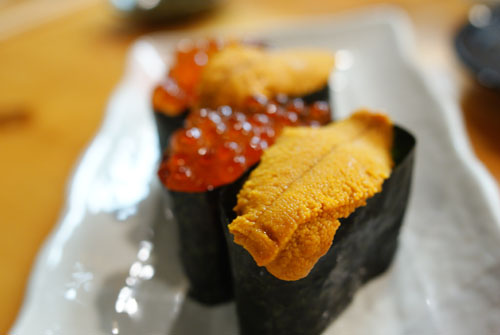
22: Uni, Ikura
Ikura and uni--egg and egg. Apparently, the combination originated from Hokkaido's famous uni ikura don rice bowl, and took off from there. I first tried the uni, from Santa Barbara, which was cold and briny, not quite as sweet or as creamy as I'd prefer. Next, the globules of salmon roe hailed from Alaska and exploded in my mouth with a pleasant pop, a burst of intense saltiness--not bad.
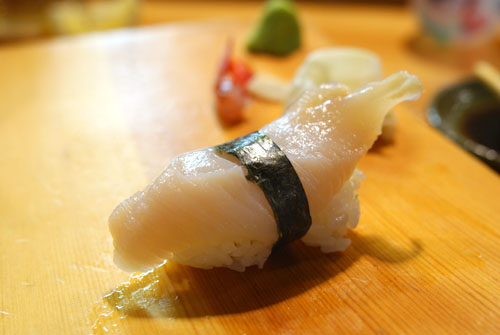
23: Mirugai
Next was mirugai, a.k.a. giant clam or elephant trunk clam. It was a bit crunchier than usual, but not too tough, still satisfying. In terms of flavor, it had a mildly briny smack, backed by a pleasant sweetness, finished by the flavor of the sushi's nori wrapper.
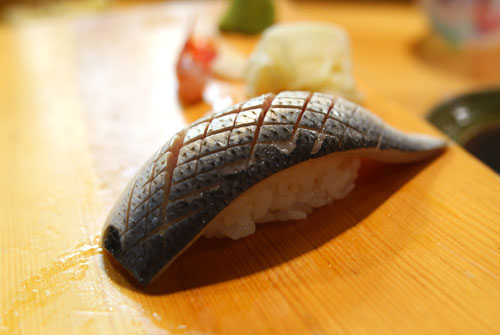
24: Kohada
Kohada is also known as Japanese gizzard shad. It was an oily, bold, robust fish, with an aggressively-flavored skin, and great, firm consistency. Note the beautiful cross-hatch pattern on the skin.
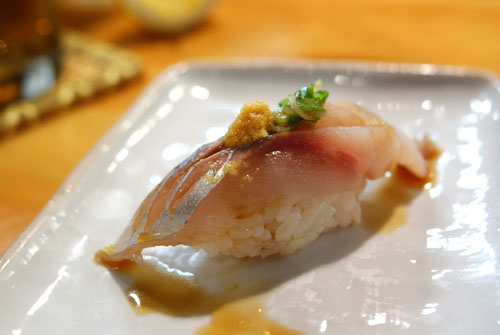
25: Aji
Aji, or Spanish mackerel, with the typical accoutrements of scallion and ginger. They're typical for a reason though--they provide a perfect balance to the flavor of the fish.
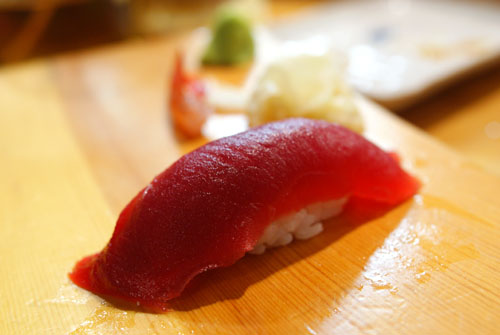
26: Maguro
Tuna, from South America. This was basically your standard maguro--it was certainly enjoyable, with a beatiful carnelian color, but didn't stand out in terms of taste.
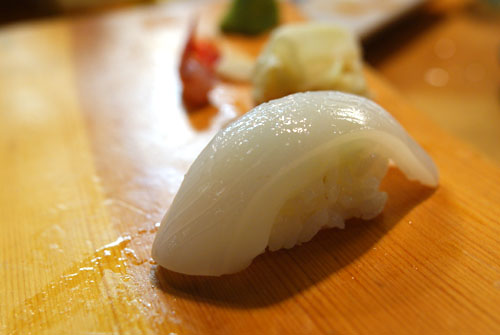
27: Ika
Next was squid from Japan. This had a creamy, sticky consistency that I expect from squid, along with a mild, soft flavor that was heightened by wasabi.

28: Hamachi
Our final piece of nigiri was yellowtail, perhaps the most common sushi ingredient out there. It used to be my favorite, back when I was a sushi neophyte, but has steadily fallen out of favor. The example here was heavy, dense, with a mild, indistinctive flavor.
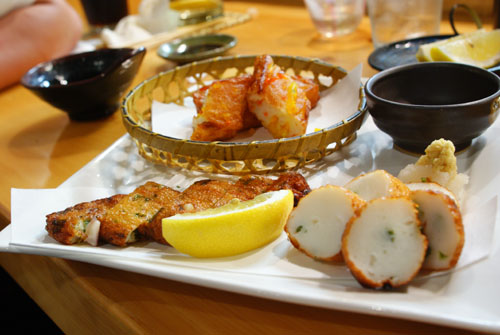
29: Fish Cake
With the sushi dispensed with, it was back to the cooked dishes, starting with this lovely selection of three different types of fish cake, paired with three accompaniments: daikon/wasabi, lemon, and a spicy dipping sauce. Given that I'm a fan of fish cake in general, I quite enjoyed their subtle sweet, yet slightly varying flavors. My favorite was the one in the lower-left, with its delightful vegetal tang finished with a touch of sour lemon.

30: Kurobuta Kakuni
Following was Kurobuta pork belly, simmered in an admixture likely containing dashi, mirin, sake, soy, and sugar. As a result of the dish's long braising time, it was expectedly tender, rich, fatty, and flavorful, with a sweet yet savory smack mitigated by the lightness of the paired vegetables.
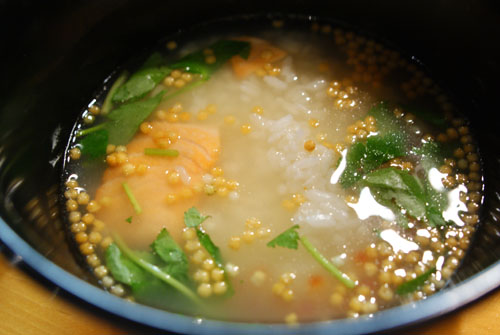
31: Ikura-Sake Chazuke
For our last savory course, we were given chazuke (or ochazuke), basically tea poured over a mix of ingredients--rice, seaweed, salmon, and salmon roe in this case. The salmon was fantastic when eaten with the seaweed, while the ikura provided a counterbalancing briny tang. Overall, a hearty, heartwarming dish that formed a fitting close to the meal.
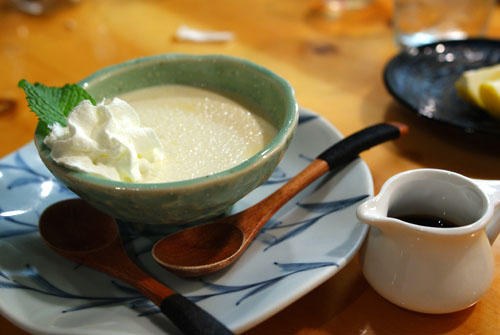
32: Goma Pudding
Our first dessert was this sesame pudding, served with black tea syrup. Eating the pudding alone, I noted a very strong, very pure essence of sesame. Pouring on the syrup elevated the sugar factor significantly.
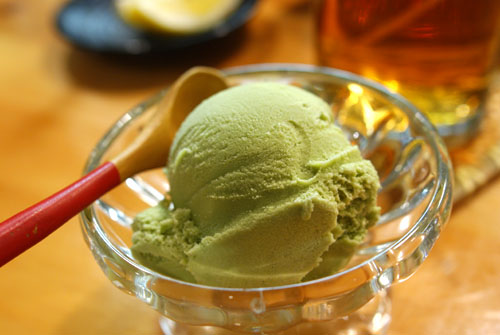
33: Matcha Aisu Kurimu
And now, for some green tea ice cream. This particular example was housemade, and was quite sweet on the attack, with the tinge of tea coming in only on the midpalate. Very good.
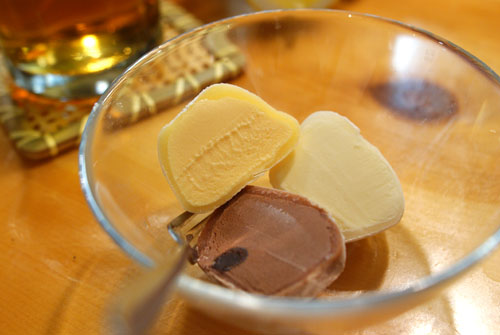
34: Mochi Aisu Kurimu
Finally, the ubiquitous mochi ice cream, here in chocolate, mango, and vanilla versions.
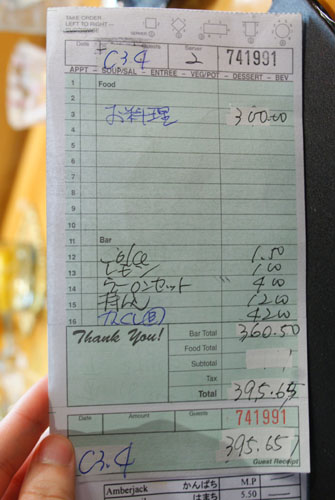
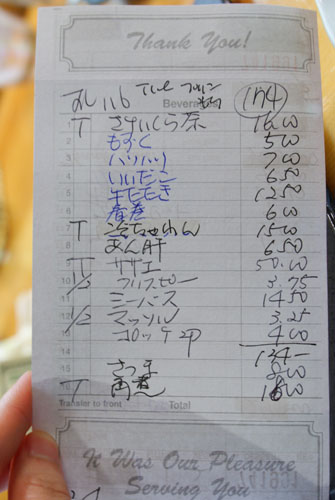
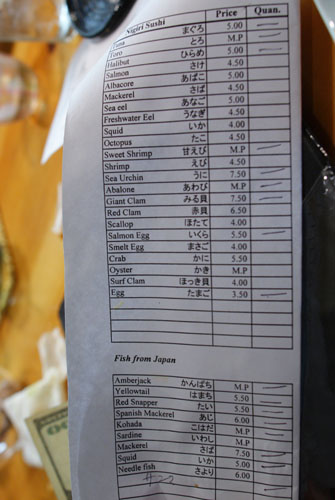
I couldn't make sense of the bill, but the bottom line was that the omakase here came out to $150 per person, higher than I expected, but not too bad given the Urasawa-level length of the meal.
Overall, I came away pretty satisfied with Izayoi. It's a fun place, with competent sushi to be sure, but the real excitement comes with the diversity of fare here: traditional izakaya-inspired food with Shiode-san's unique touch. Give it a shot if you're looking for something else besides mere sushi.
132 S Central Ave, Los Angeles, CA 90012
213.613.9554
www.fooddigger.com/RestaurantDetail.aspx?id=20900 (FoodDigger, restaurant has no web site)
Wed 08/26/2009, 07:50p-10:50p
Izayoi's story begins with its owner and head chef, Junichi Shiode, who previously helmed Sushi Ryo, a well-regarded, but not particularly bustling place in Hollywood. Though a favorite of those in-the-know, Shiode-san shuttered Sushi Ryo and reincarnated the place as Izayoi in June of 2005. Izayoi is considered an izakaya, basically a Japanese restaurant primarily focusing on small plates, or "tapas"-style food meant to be eaten while drinking (alcohol). It's a relatively uncommon concept here in the States, but has been catching on in recent years.

Located in the heart of Little Tokyo, Izayoi is situated along a row of modern-looking storefronts, right next to a Quizno's. Catty-corner is infamous yakitori-ya Kokekokko, which just happens to be one of Shiode-san's favorite restaurants. Parking is free in the nearby Office Depot lot. Note the "B" rating, par for the course for Chinese joints, but rare among Japanese eateries.

Inside, the room is split between a large, open kitchen-cum-sushi bar and table seating. It's a fairly austere, but comfortable, environment.

To drink, we started with the Harushika Junmai Daiginjo sake, which was brought by Dason, a reader of mine whom I'd met the previous night at Providence. Harushika means "spring deer," and is a 50% seimaibuai sake from Nara Prefecture. It was soft, smooth, and easy-drinking, with a light fruitiness over a backbone of sweet rice--quite delicious. I'd had Harushika's namazake previously at Urasawa, and their junmai at R23; both were positive experiences.

1: Mozuku
This was my first experience with mozuku, a type of seaweed primarily from Okinawa. It had a very fine, very stringy consistency with a bit of crispness to boot, and was served here in a transparent, slimy, gelatinous mass. Flavor-wise, the mozuku was sweet and briny, with a delightful finish of ginger. A nice start to the meal.

2: Mixed Green Salad
We moved on to a light, refreshing salad. I appreciated its slightly bracing tang and crunchy texture, along with its simultaneously sweet and savory flavor. The most interesting part of the dish, though, was the use of slivers of you tiao, or Chinese-style fried breakfast doughnuts, which added a palpable weight to the salad.

3: Idako
This was fried baby octopus from Japan. Initially, I tasted the crisp, rich, savory, oily crust, but this then gave way to the chewy, subtly sweet flesh of the octopus, which was immensely satisfying. Superb.

4: Beef Tataki
A presentation of seared beef filet sashimi, accompanied by onion and daikon oroshi. The meat itself was actually quite mild, so the key was to experience the contrast between the tangy onion and sweet daikon over the canvas of beef.


5: Sazae Tsuboyaki
This was a first for me: sazae, or turban shell, a type of sea snail. Here, it was done tsuboyaki-style, grilled in its own shell with kombu. I'll admit that it was a rather intimidating-looking dish when it was brought out, and note the large calcareous operculum "door" to the shell, removed in the second photo. The sazae's flesh was snappy, sweet, and slightly briny, with a bit of savory char flavor as well. I also had the snail's innards, which were mildly bitter; the entrails' strong taste was tempered by the use of kombu, which lent a great, vegetal tang to the entire dish.

6: Ebi-Jalapeno Spring Roll
Taken by itself, the shrimp was sweet, soft, and nicely contrasted by the roll's crunchy wrapper. However, the key here was the jalapeno and the hot dipping sauce, both of which accented the shrimp's sweetness beautifully with a distinct spiciness. One of the best egg rolls I've had.

With our sake dispensed with, it was time to move on to the harder stuff: shochu, specifically the Kakushigura Mugi barley shochu from Hamada Shuzo brewery in Kagoshima [$42]. Aged in oak, which explains the drink's golden tinge, it had a woody, smoky, earthy aroma that was distinctive yet smooth, almost reminiscent of whiskey in fact. Here, we had it on the rocks, as well as mixed with oolong tea.

7: Cold Chawanmushi
Just in time for summer was this refreshing chawanmushi, served cool, containing egg, chicken, shiitake, uni, kamaboko (fish cake), fresh wasabi, and nori. It was definitely one of the better chawanmushis I've had, with the chicken adding a superb textural play and gravity to the dish, while the wasabi provided an excellent counter to the creaminess and weight of the egg.

8: Spicy Tuna
The following bite was spicy tuna tartare, topped with scallion, atop a crispy rice cracker. A seemingly pedestrian dish, it was nonetheless delicious. I first was able to experience and enjoy the mild creaminess of the tuna, with the heat coming in only later on the lingering finish. The rice cracker, meanwhile, proved a superb textural contrast.

9: Ankimo
Ankimo, or monkfish liver, accompanied by scallion, momiji oroshi, kombu, and cucumber. This "foie gras of the sea" was noticeably milder than most, with a slight brine that was countered by the cool, crisp cucumber.

10: Chilean Sea Bass
Though I'm not a huge fan of Chilean sea bass, I did enjoy this preparation, marinated in miso. This gave the fish a slightly sweet flavor to go along with its unctuous, oily savoriness and supremely flavorful skin. At the same time, the tart pickles were key in balancing the weight of the soft, tender flesh. It actually reminded me a lot of Nobu's world-famous miso-marinated black cod.


11: Mussel, Croquette, Shrimp Head
Our last course before the sushi gauntlet was this troika, served with two condiments: a tonkatsu sauce and a ketchup/mayo/honey sauce. I started with the mussel, baked in tomato sauce. The sauce added a significant gravity to the mollusc, tempering its brine with a marked sweetness. Next up was the shrimp croquette, my favorite of the trio: creamy, sweet, soft, with lovely chunks of shrimp interspersed within. Finally, we had shrimp heads, briny and sweet, with the body to be served next.

12: Amaebi
We had the head, now we have the body. This was basically your archetypical amaebi--snappy translucent flesh, lightly salty, subtly sweet, heightened by a finish of wasabi. Quite good.

13: Sazae
Remember the sazae above? Before, we ate the body of the snail, now we'll consume the rather funky-looking foot. It was exceedingly crunchy, almost rubbery in fact, and had a very briny, ocean-y flavor that was fortunately countered by wasabi.

14: Sanma
A.k.a. pike mackerel, this is something I'd only had before at Urasawa. However, while Hiro-san "grills" the fish with a hot, long rod, the sanma here was served completely raw. It was delicious, with a prominent, yet delicate fishiness.

15: Toro
This looked quite dark for toro, so I was pleasantly surprised when I found that it was super soft, melt-in-my-mouth almost, and quite unctuous, though it wasn't as rich or as oily as the best toros I've had. Still, it was rather tasty.

16: Awabi
Though the awabi here looked like that from Go's Mart, it didn't have Go's divine texture, being quite a bit crunchier. Nevertheless, it did have a brackishly sweet flavor to it, and went superbly with the rice.

17: Engawa
Engawa is a relatively rare item, one that I've only had before at Sasabune and Sushi Zo. It's basically halibut fin muscle, normally a tougher cut of the fish. This preparation, however, was surprisingly tender, with a great sour/salty tang thanks to the yuzu kosho. Impressive.

18: Kanpachi
Up next: kanpachi, or amberjack. In terms of taste, it was fairly typical, with a clean, mild flavor accented by the fire of wasabi. It was more impressive texturally, with a creamy, yet subtly snappy body.

19: Saba
This was mackerel from Japan, topped with kombu. Though saba can often times be an assertive-tasting fish, it was tempered significantly here by the seaweed, which resulted in an almost sweet flavor to the sushi.

20: Shiro Sake
Now here was a first for me: "white salmon" from Alaska. Also known as "ivory salmon," it's a type of King salmon with an extra enzyme that can process the carotene that normally collects in and colors a salmon's flesh. It was quite a different beast indeed, with a much heavier, heartier complexion, but blunter, milder taste.

21: Tamago
Tamago in the middle of the meal seemed a bit strange, but we went with the flow. It was a cold, dense version, with your prototypical sweetness, but also possessing a great seaweed tang.

22: Uni, Ikura
Ikura and uni--egg and egg. Apparently, the combination originated from Hokkaido's famous uni ikura don rice bowl, and took off from there. I first tried the uni, from Santa Barbara, which was cold and briny, not quite as sweet or as creamy as I'd prefer. Next, the globules of salmon roe hailed from Alaska and exploded in my mouth with a pleasant pop, a burst of intense saltiness--not bad.

23: Mirugai
Next was mirugai, a.k.a. giant clam or elephant trunk clam. It was a bit crunchier than usual, but not too tough, still satisfying. In terms of flavor, it had a mildly briny smack, backed by a pleasant sweetness, finished by the flavor of the sushi's nori wrapper.

24: Kohada
Kohada is also known as Japanese gizzard shad. It was an oily, bold, robust fish, with an aggressively-flavored skin, and great, firm consistency. Note the beautiful cross-hatch pattern on the skin.

25: Aji
Aji, or Spanish mackerel, with the typical accoutrements of scallion and ginger. They're typical for a reason though--they provide a perfect balance to the flavor of the fish.

26: Maguro
Tuna, from South America. This was basically your standard maguro--it was certainly enjoyable, with a beatiful carnelian color, but didn't stand out in terms of taste.

27: Ika
Next was squid from Japan. This had a creamy, sticky consistency that I expect from squid, along with a mild, soft flavor that was heightened by wasabi.

28: Hamachi
Our final piece of nigiri was yellowtail, perhaps the most common sushi ingredient out there. It used to be my favorite, back when I was a sushi neophyte, but has steadily fallen out of favor. The example here was heavy, dense, with a mild, indistinctive flavor.

29: Fish Cake
With the sushi dispensed with, it was back to the cooked dishes, starting with this lovely selection of three different types of fish cake, paired with three accompaniments: daikon/wasabi, lemon, and a spicy dipping sauce. Given that I'm a fan of fish cake in general, I quite enjoyed their subtle sweet, yet slightly varying flavors. My favorite was the one in the lower-left, with its delightful vegetal tang finished with a touch of sour lemon.

30: Kurobuta Kakuni
Following was Kurobuta pork belly, simmered in an admixture likely containing dashi, mirin, sake, soy, and sugar. As a result of the dish's long braising time, it was expectedly tender, rich, fatty, and flavorful, with a sweet yet savory smack mitigated by the lightness of the paired vegetables.

31: Ikura-Sake Chazuke
For our last savory course, we were given chazuke (or ochazuke), basically tea poured over a mix of ingredients--rice, seaweed, salmon, and salmon roe in this case. The salmon was fantastic when eaten with the seaweed, while the ikura provided a counterbalancing briny tang. Overall, a hearty, heartwarming dish that formed a fitting close to the meal.

32: Goma Pudding
Our first dessert was this sesame pudding, served with black tea syrup. Eating the pudding alone, I noted a very strong, very pure essence of sesame. Pouring on the syrup elevated the sugar factor significantly.

33: Matcha Aisu Kurimu
And now, for some green tea ice cream. This particular example was housemade, and was quite sweet on the attack, with the tinge of tea coming in only on the midpalate. Very good.

34: Mochi Aisu Kurimu
Finally, the ubiquitous mochi ice cream, here in chocolate, mango, and vanilla versions.



I couldn't make sense of the bill, but the bottom line was that the omakase here came out to $150 per person, higher than I expected, but not too bad given the Urasawa-level length of the meal.
Overall, I came away pretty satisfied with Izayoi. It's a fun place, with competent sushi to be sure, but the real excitement comes with the diversity of fare here: traditional izakaya-inspired food with Shiode-san's unique touch. Give it a shot if you're looking for something else besides mere sushi.
22 Comments:
kevin - thanks for sharing your review on the spot. izayoi is one of my favorite spots, having followed jun from his days at sushi ryo - it is close to my heart. glad you enjoyed it.
This comment has been removed by the author.
Far be it for me to be preachy, but I think you need to be more selctive in some of the food that you choose to consume. As you may know, Chilean Sea Bass is a fish that has been severely over-fished, and restaurants like Le Bernardin refuse to serve it for political/ethical reasons.
If this was your only offense, i believe that you could claim ignorance, but in your Ortolan review, you asked if the restaurant would serve the bird and you would love to eat it. Again, as I am sure you know, Ortolan is protected species and is illegal to eat, let alone ship to the US for consumption.
Lastly, in a review--I belive for the Meadowood in Northern California--you requested Beluga caviar. Beluga caviar is also illegal, due to inanely high amounts of poaching and illegal trade.
I think yours might be a case of having more money than common sense. For somebody who loves food, you should probably stop trying to proliferate the misuse and abuse of it.
kevin,I'm happy that you enjoy the meal. I hope I still able to join you in the near furture when I'm in LA.
As for the bill, it actually break in half, "kitchen" and "sushi" and the dessert in not on the bill, sorry if it is high than you except, but I hope it still worth.
Finally I have to say it for the record sake, our organial plan for Kappo Ishito, they received a "B".
Ooh I want to try turban shell!
Ivory (white) Salmon is not as "fishy" tasting as other Salmon but is also very high in Omega-3 oils. White Salmon are extremely rare, it can only be caught for weeks mainly in Alaska. It's whole sales price are ~$120/lb. Wild salmon will taste better and are healthier for you and for the environment.
As some sale slogan goes, "Wild salmon don't do drugs." the reason is
most salmon in the market are farm rasie because consumers have shown a reluctance to purchase nature fleshed salmon, astaxanthin (E161j) and very minutely canthaxanthin (E161g) are added as artificial colorants to the feed, which will cause the flash to change its color.
The fellowing are the salmon which are avaiable in the market according to it rareity and it price.
Ivory/White King Salmon - wild
Chinook/King Salmon - wild
Coho/Silver Salmon - wild
Sockeye/Red Salmon -wild
Atlantic Salmon - the one you usually get in the store which are farm raise, the wild one rare since they are listed as an endangered species in part of US.
Pink and Chum Salmon - canned food
Steelhead and BC trout - not salmon but in the same family, both are illegal since they are list as an endangered species in the whole US, unless you know Native American fishermen whom are the only one who can keep when they caught it.
Steelhead trout - not much to it, that what you find in your local market
The reason tamago sushi serve in the middle is because I order it after you ask me how it was, that also go for the Cold Chawanmushi and Akimo, I order those after our discussion.
Maguro, Ika and Hamachi are add on caz' we want more sushi. Since you said you still hungry, the fish cake and Kurobuta Kakuni are also add on. That goes for dessert as I mention "dessert" are not part of Japanese Meal, we eat sweet/dessert as snack through out the day, but not after the meal.
Finally for your question - Uni and Ikura serve together, the only reason I come up with is something to do with Okkaido's Uni-Ikura-Don. Okkaidian beleiev those two item able to companment each other if serve together on rice. Japanese people just start accepting it as a "fact" and start serving most thing that way on any from of rice dish.
I am impressed you spent $150/head at Izayoi. I just go for "small eats." :)
This comment has been removed by the author.
This comment has been removed by the author.
Hi there. Long time lurker, I love your site! I was excited to see engawa featured since I just had it for the first time this weekend at Sushi Maru in downtown San Jose, Ca. The restaurant was ok but the engawa really stood out. I had never had it before. The fish was lightly broiled and it was fatty and delicious!
One of my favorite restaurants in town, what a lovely review. The way they serve ankimo and chawanmushi there is delightful. Must try the beef tataki. During the culinary tour of Little Saigon I came across the turban shell, and had no clue what it was. Now I know, and am unsure if I am any closer to trying it, even with Shiode-san cooking it for me.
Nice review and wonderful pictures Kevin. My friend lives right across the street and I have passed it many times on my to Starbucks and Yogurtland and I always judged the place by its odd location (it being in the middle of all these chains). Now, I will give this place a try.
-Wesley
Tricerapops: How would you compare Izayoi to Sushi Ryo?
Concerned: When you preface something with "Far be it for me to be preachy," I can pretty much rest assured that it will be just that.
Though concerns have been raised about over-fishing of Chilean sea bass, the fish is not currently endangered, and is caught completely legally in many cases.
The IUCN lists the ortolan's status as "Least Concern," so it's not as endangered as you think apparently.
Lastly, there was an international ban on beluga harvesting back in 2006, but this was lifted in 2007, though the US did not follow suit. The restaurant in question was Cyrus not Meadowood, and we merely inquired about it.
So calm down.
Dason: Thanks for the additional info about the white salmon and uni/ikura; I'll augment the original post with those points. I don't really have a problem with the "B." A "C," however, would raise eyebrows!
Jo: Yeah that was the most fascinating item of the night, a real first for me!
Weezer: I was impressed too. ;)
gtrine: Thanks. Engawa is a real treat, and I look forward to every chance I have to eat it.
Liz: I fully expect to see the sazae on your blog in the near future. See you Wednesday!
Wesley: Be sure to let us know what you think. How come you aren't coming to BondSt?
Love the white out on the check, that's classic.
Indeed, that's a long meal. I'm surprised you had so many sushi courses at an izakaya. Also first time I've seen sea snail nigiri
I've had a few decent meals (in way less courses) at Izayoi, and indeed, it's a fun place to have a little of this, little of that -- "beyond mere sushi" that they do a good job with as well (though I'm always wary of 'B'-rated places serving raw fish) ~ my favorite dish there, though, is definitely the scallops & mushrooms sauteed in garlic butter (un-japanesy as that may be.)
There was only one seat for us because this is a really small event. Evelina is going to cover this once since I was at the Ludo Bites even.
Looks like a great meal. I'm looking forward to try it in the future!
svnty3stingray: At least it was correction tape, and not actual Wite-Out. ;)
Aaron: Well, we were seated at the bar, in front of the owner/master sushi chef, so it sort of made sense. Next time though, I'll probably sample more izakaya-style dishes.
HC: Yeah the 'B' and raw fish combo was sitting in the back of my mind too heh. Scallops and mushrooms sounds good right about now.
Wes: Got it. Well I guess I'll see your other half tonight.
Danny: Looking forward to finding out what you think of the place!
I've walked by this place so many time not really giving it a thought. Thanks to your review I might actually check it out in the future. Thanks Kevin.
And Concerned, Kevin pretty much said what I was going to say so the only thing I have to ask is if you drive a car, have ever shopped at Walmart and have any leather clothing and if your showers are longer than 5 minutes? Give me a break.
kevin!! proud of you. stood up and corrected the PETA person with her overblown and incorrect lecturing. they should jump on a greenpeace ship or learn how to drive their prius before insulting people on their food blog sites.
also, a restaurant whose plumbing goes out on the day of the city visit can get a bad rating and that rating has to stay up all month even if they fix it that day or the next as far as i know. they revisit a month later to see if the problem is taken care of.
paul
Post a Comment
Subscribe to Post Comments [Atom]
<< Home